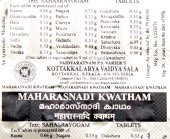Vriddhadaru, Vṛddhadāru: 4 definitions
Introduction:
Vriddhadaru means something in Hinduism, Sanskrit, biology. If you want to know the exact meaning, history, etymology or English translation of this term then check out the descriptions on this page. Add your comment or reference to a book if you want to contribute to this summary article.
The Sanskrit term Vṛddhadāru can be transliterated into English as Vrddhadaru or Vriddhadaru, using the IAST transliteration scheme (?).
Biology (plants and animals)
Source: Wisdom Library: Local Names of Plants and DrugsVriddhadaru [वृद्धदारु] in the Marathi language is the name of a plant identified with Argyreia nervosa (Burm. f.) Bojer from the Convolvulaceae (Morning glory) family having the following synonyms: Argyreia speciosa, Convolvulus nervosus, Lettsomia nervosa. For the possible medicinal usage of vriddhadaru, you can check this page for potential sources and references, although be aware that any some or none of the side-effects may not be mentioned here, wether they be harmful or beneficial to health.
Vrddhadaru [वृद्धदारु] in the Sanskrit language, ibid. previous identification.
Vrddhadaru in the Sanskrit language is the name of a plant identified with Salvia plebeia R.Br. from the Lamiaceae (Mint) family having the following synonyms: Salvia brachiata, Salvia minutiflora.
Source: Google Books: CRC World Dictionary (Regional names)Vrddhadaru in India is the name of a plant defined with Argyreia nervosa in various botanical sources. This page contains potential references in Ayurveda, modern medicine, and other folk traditions or local practices It has the synonym Convolvulus nervosus Raf. (among others).
Example references for further research on medicinal uses or toxicity (see latin names for full list):
· Flora Indica, or ‘Descriptions of Indian Plants’ (1832)
· Hortus Bengalensis, or ‘a Catalogue of the Plants Growing in the Hounourable East India Company's Botanical Garden at Calcutta’ (1814)
· Vilm. Blumengärtn., ed. 3 (1895)
· Mémoires de la Société de Physique et d’Histoire Naturelle de Genève (1833)
· Flora Peruvianae, et Chilensis Prodromus (1794)
· Botanische Jahrbücher für Systematik, Pflanzengeschichte und Pflanzengeographie (1893)
If you are looking for specific details regarding Vrddhadaru, for example pregnancy safety, health benefits, extract dosage, side effects, diet and recipes, chemical composition, have a look at these references.

This sections includes definitions from the five kingdoms of living things: Animals, Plants, Fungi, Protists and Monera. It will include both the official binomial nomenclature (scientific names usually in Latin) as well as regional spellings and variants.
Languages of India and abroad
Sanskrit dictionary
Source: Cologne Digital Sanskrit Dictionaries: Monier-Williams Sanskrit-English DictionaryVṛddhadāru (वृद्धदारु):—[=vṛddha-dāru] [from vṛddha > vṛdh] n. Argyreia Speciosa or Argentea, [cf. Lexicographers, esp. such as amarasiṃha, halāyudha, hemacandra, etc.]
[Sanskrit to German]
Sanskrit, also spelled संस्कृतम् (saṃskṛtam), is an ancient language of India commonly seen as the grandmother of the Indo-European language family (even English!). Closely allied with Prakrit and Pali, Sanskrit is more exhaustive in both grammar and terms and has the most extensive collection of literature in the world, greatly surpassing its sister-languages Greek and Latin.
See also (Relevant definitions)
Partial matches: Vriddha, Daru, Taru.
Starts with: Vriddhadaruka.
Full-text: Sukshmapattra.
Relevant text
No search results for Vriddhadaru, Vṛddhadāru, Vrddhadaru, Vriddha-daru, Vṛddha-dāru, Vrddha-daru; (plurals include: Vriddhadarus, Vṛddhadārus, Vrddhadarus, darus, dārus) in any book or story.
Related products





